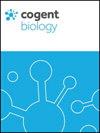Population genetic copy number variation of CHKB, KLF6, GPC1 and CHRM3 genes in Chinese domestic yak (Bos grunniens) breeds
引用次数: 0
Abstract
Abstract Single nucleotide polymorphisms (SNPs) are common markers used for population genetics studies. Recently, copy number variations (CNVs) have been used to study genetic and phenotypic diversity within and among populations. Therefore, studies of the genetics of CNVs are important in the context of understanding evolutionary changes and genomic selection based upon genetic and phenotypic variation. The aim of this study was to analyse the distribution of the choline kinase beta (CHKB), Krüpple-like factor 6 (KLF6), glypican 1(GPC1) and cholinergic receptor muscarinic 3 (CHRM3) genes in five representative Chinese domestic yak breeds. The data generated by qPCR was transformed into log2 ratio and analysed using GraphPad (PRISM). The results show that the CNVs of CHKB, KLF6, and GPC1 genes presented more copy number losses in Tianzhu, Gannan and Plateau yak populations compared with the Datong and polled yak having relatively more copy number gains. However, the CHRM3 CNV showed more copy number gains in five yak populations. Therefore, these results indicate that there are relatively more copy number losses (deletion) in the yak populations; supporting the hypothesis that log2 ratio is more powerful at detecting loss than gain in copy number types. Taken together, these data provide information on the application genome CNVs in population genetics and suggest that the CNVs of the genes could exert a significant effect on phenotypic differences in yak populations.中国家牦牛CHKB、KLF6、GPC1和CHRM3基因的群体遗传拷贝数变异
摘要单核苷酸多态性(SNPs)是群体遗传学研究中常用的标志物。最近,拷贝数变异(CNVs)已被用于研究群体内部和群体之间的遗传和表型多样性。因此,对CNVs遗传学的研究对于理解基于遗传和表型变异的进化变化和基因组选择具有重要意义。本研究的目的是分析胆碱激酶β(CHKB)、Krüpple样因子6(KLF6)、糖蛋白1(GPC1)和胆碱能受体毒蕈碱3(CHRM3)基因在中国五个有代表性的牦牛品种中的分布。将qPCR生成的数据转换为log2比率,并使用GraphPad(PRISM)进行分析。结果表明,与大同牦牛相比,天柱、甘南和高原牦牛群体中CHKB、KLF6和GPC1基因的CNVs的拷贝数损失更大,轮询牦牛的拷贝数增加相对更多。然而,CHRM3CNV在五个牦牛群体中显示出更多的拷贝数增加。因此,这些结果表明,牦牛种群的拷贝数损失(缺失)相对较多;支持log2比率在拷贝数类型中检测丢失比检测增益更有力的假设。总之,这些数据提供了基因组CNVs在群体遗传学中的应用信息,并表明这些基因的CNVs可能对牦牛群体的表型差异产生显著影响。
本文章由计算机程序翻译,如有差异,请以英文原文为准。
求助全文
约1分钟内获得全文
求助全文

 求助内容:
求助内容: 应助结果提醒方式:
应助结果提醒方式:


